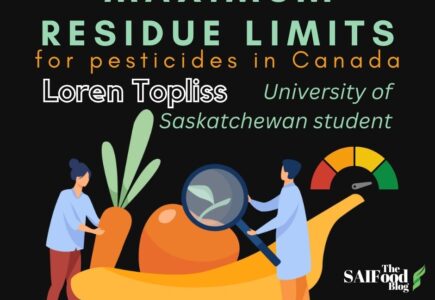By: Loren Topliss
University of Saskatchewan student
A common public misconception is that a pesticide’s role is to kill insects, when truthfully, a pesticide is a blanket term for all chemical substances that are used to prevent, eradicate, or repel any unwanted pest in agriculture. A pest doesn’t always mean an insect. The word “pest” is used to identify fungi, weeds, and insects. The blanket term “pesticide” includes fungicides, herbicides, and insecticides, which all have specified uses to aid in the outcome of a crop while being regulated by the Government of Canada’s Pest Management Review Agency (PMRA).
What is a pesticide?
Pesticides are used at different periods in a growing season for many different purposes:
Fungicides are used to control fungi and their spores, preventing disease from damaging crops. The usage of fungicides is a preventative application and is applied as soon as disease is detected. To inhibit the spread of the fungus further into the crop, fungicides are used to salvage crops from the damage that can/has been done, this process is usually reversible, hence why controlling it is the only option to control the further spread of the fungi.
Herbicides are used to control undesirable vegetation in a field to allow the desired crop to grow. These are “weed killers” used before and during the season to maximize the outcome of the crop by allowing the desired plants to grow ahead in the weeds. This is done so that the crop doesn’t have to compete for nutrients with the undesired weeds.
A desiccate herbicide is sprayed near the end of a growing season to adjust the crop to the same stage of growth. Drying down the plants to an even growth stage, allows producers to harvest the field all at once.
Insecticides are used to kill insects/insect larvae that physically damage crops throughout the growing season. Insects can destroy a whole field of crop before the plants become mature which is why they are typically applied while the crop is still immature.
All pesticides have regulations for use set in place by the PMRA to ensure human safety on when and how much can be sprayed.
How are pesticides regulated?
The Government of Canada has put in place regulations that allow producers to use pesticides to protect our food system to supply the world. Maximum Residue Limits (MRLs) are determined before pesticides are allowed to be sold to be used for food/feed products. All pesticides have a label rate indicating the amount of chemical recommended to be sprayed by the producer. This value is determined with vigorous testing by third-party companies to ensure there is no bias from chemical companies. Companies follow strict regulations “all of which meet or exceed the requirements of the [The Organisation for Economic Co-operation and Development Principles of Good Laboratory Practice (OECD GLP)] regulations, the United States Environmental Protection Agency (EPA) 40 CFR Part 160 in the Federal Insecticide, Fungicide and Rodenticide (FIFRA) Act, and Health Canada’s Pest Management Regulatory Agency (PMRA) Regulatory Directive, DIR98-01, Good Laboratory Practice.” These research companies are recognized by the Standards Council of Canada, allowing their research to be recognized across the world. Being a company that is recognized across the world indicates that when these researchers conclude their results, their findings will be repeatable in other countries that follow the same Standard Operating Procedures (SOPs). This allows companies and governments to acknowledge the research conducted and use the results without doing extensive research for themselves, wasting time and money, as it has already been concluded with results that have been verified in numerous growing areas and conditions. By being a country that follows these GLPs and SOPs, it reduces the time between manufacturing the chemical, and the time it gets to market with the same amount of safety precautions taken.
Companies like AgQuest will conduct field trials on a small scale that is representative of commercial practice. In doing so, researchers will follow specific requirements regarding the staging time, chemical amount, and adjuvant rates set by the chemical company to be applied to a crop for research to be collected. These plots will be sampled at different stages of growth after the application and sent to a lab to be tested for residue limits. This process is strict to prevent contamination of the samples ensuring the chemicals detected on the crop are accurate and repeatable.
The information gathered from these field trials is then used to determine the label rate for each and every chemical. In research, situations like spraying a rate that can be near five times the recommended amount for the feed/food chain, researchers are able to determine the safe limit of the active ingredient allowed on crops (Ramsay, C Personal Communication, 2022). This number is then used to set the label rate well below what is harmful. The importance for researchers to gather this data at such a high rate is to consider human and mechanical errors, including overlapping during application or a miscalculation during mixing on the farm while still being safe for food/feed.
Are pesticides bad for you?
The Canadian Food Inspection Agency (CFIA) enforces regulations for all food/feed in Canada (domestic and international) to be tested for chemical and pesticide residue before entering the food chain. This means that all food consumed by humans and animals is safe and won’t cause health issues from the crops that have been sprayed. The Government of Canada has concluded that “there is no scientific evidence to show that there is a health risk from eating conventionally grown produce because of pesticide residues, or that organic foods are safer to eat than conventionally produced foods.”
As glyphosate has been a major topic in the news lately, I believe it is fair to compare residue limits with common ingredients in the standard Canadian household. Many substances have been measured for their median lethal dose (LD50) which measures the lethal dose of a given substance that causes death to 50% of the test group which is to test the acute toxicity of a material. From these tests, the more a material can be dosed, the safer it is if consumed (the bigger the number the safer it is to consume). When comparing glyphosate to household materials, glyphosate has an LD50 score of 4,900mg/kg of body weight, making it less toxic than table salt (which has an LD50 of 3,000mg/kg) and nearly two times less toxic than Tylenol (with an LD50 of 1,944mg/kg). This results in the conclusion that food/feed products that have been sprayed with glyphosate are safe to consume as stated by the Government of Canada and numerous testing facilities.
As Glyphosate does not pass through skin very easily, the LD50 measurement equivalent for a consumed commodity would be 1,400 kg of lentils for a rat which the LD50 was tested on. This amount of lentils would have to be consumed in a short period of time for the exposure to reach the maximum residue limit. Glyphosate is poorly metabolized by both plants and animals which is why we have found studies demonstrating findings of glyphosate in the liver, kidneys, feces, lungs, and breast milk which are the bodies excretory organs to release the chemical out of the body with only about 1% of glyphosate going through metabolism. At the levels set by the MRL, the 1% that goes through metabolism the body is cleared of the chemical within 48 hours with no damages caused due to the limit being so low.
Where do we go now?
As it has already been stated, consuming food/feed that has been sprayed with chemicals is safe for humans and animals. With the use of these pesticides, it has allowed producers to increase their yield, and production as a whole. With a growing population, the use of these pesticides is what will contribute to the growth of feeding the world and reducing food insecurity. Consumers have stated their concerns with the use of chemicals in our food chain, but it has been reinstated by trusted companies with exceptional regulations, that it is indeed safe to consume at respectable rates.
While pesticides cause no threat to our food systems and are safe to consume after their preharvest interval period, it is important to include that while direct contact with these chemicals is rare, insecticides are dangerous to come in contact with while in their active form. Producers should follow SOPs while handling these chemicals due to potential harm to the human body. Once the insecticides are sprayed, there is a residue timing (preharvest interval) where the chemicals are active to kill insects where humans shouldn’t be near them. After this period has passed, there are no health concerns for producers near the field or humans consuming the products.
When following labels, reading safety data sheets, and following handling instructions, pesticides are not unsafe or unhealthy. Pesticides are allowing agriculture practices to be more sustainable in providing food to the world. Without them, producers wouldn’t be able to harvest the quantities needed to feed the world. With regulations set in place by the government to ensure human safety, pesticide use causes no risk to human health.
Biography

My name is Loren Topliss, and I am in my fourth year pursuing a Bachelor’s Degree in Animal Science with a minor in Agribusiness at the University of Saskatchewan. At the beginning of my degree, I was more focused on the animal side of agriculture but as my path in university continued, I found a large disconnect between the industry and the rest of the world. This only grew my passion for being a voice in clearing up misconceptions consumers may have about the industry. During the past two summers, I’ve had the opportunity to work in crop research developing an understanding of how crops connect further with the food and feed system with regulations that ensures to keep animals and people safe. With my experience in animal science, crop research, agribusiness, and with the help from my wonderful professors, my only hope is to connect my passions to show the world how Canadian agriculture is a resourceful and innovative industry.

